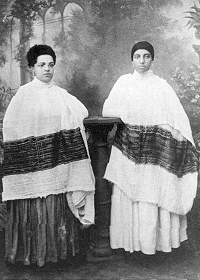Related Research Articles

Niamh is the lover or spouse of Oisín, son of Fionn mac Cumhail, in the Fianna Cycle of Irish mythology.

Gudit is the Classical Ethiopic name for a personage also known as Yodit in Tigrinya, and Amharic, but also Isato in Amharic, and Ga'wa in Ţilţal. The person behind these various alternative names is portrayed as a powerful female ruler, probably identical to Māsobā Wārq, the daughter of the last Aksumite king, Dil Na'ad, mentioned in an early Arabic source. She is said to have been responsible for laying waste the Kingdom of Aksum and its countryside, and the destruction of its churches and monuments in the 10th century AD. If she is the same as the Tirda' Gābāz in other Ethiopian sources, she is also said to have attempted to exterminate the members of the ruling dynasty. The deeds attributed to her are recorded in oral tradition and in a variety of historical narratives.
Ethiopian music is a term that can mean any music of Ethiopian origin, however, often it is applied to a genre, a distinct modal system that is pentatonic, with characteristically long intervals between some notes.

Menelik I was the legendary first Emperor of Ethiopia. According to Kebra Nagast, a 14th-century national epic, in the 10th century BC he is said to have inaugurated the Solomonic dynasty of Ethiopia, so named because Menelik I was the son of the biblical King Solomon of ancient Israel and of Makeda, the Queen of Sheba.
P'ent'ay is an originally Amharic–Tigrinya language term for Pentecostal Christians. Today, the term refers to all Evangelical Protestant denominations and organisations in Ethiopian and Eritrean societies. Alternative terms include Ethiopian–Eritrean Evangelicalism or the Ethiopian–Eritrean Evangelical Church. Sometimes the denominations and organizations are known as Wenigēlawī.
Queen ʿArrawelo or ʿArraweelo ', also known as Ebla Awad, was a proto-Somali Queen in traditional folklore.

Health in Ethiopia has improved markedly since the early 2000s, with government leadership playing a key role in mobilizing resources and ensuring that they are used effectively. A central feature of the sector is the priority given to the Health Extension Programme, which delivers cost-effective basic services that enhance equity and provide care to millions of women, men and children. The development and delivery of the Health Extension Program, and its lasting success, is an example of how a low-income country can still improve access to health services with creativity and dedication.

Tsegaye Kebede Wordofa is an Ethiopian long-distance runner who competes in road running events, including marathons. He quickly rose to become a prominent distance runner after his international debut at the Amsterdam Marathon in 2007. In his second year of professional running, he won the Paris Marathon, the Fukuoka Marathon and the marathon bronze medal at the 2008 Beijing Olympics.
Enderta or Inderta is a former historical province of Ethiopia; it is located in the eastern edge of the Tigray highlands. Enderta is bordered on the west by Tembien, on the south and southwest by Lasta and Wag, on the east by denkel, and on the north by Agame and Adwa. Mekelle was formerly the capital of the province. Enderta's local administration of Denkel/Afar up to the edges of Aseb under its jurisdiction seems to have been highly, interlinked with the operation of the salt trade and its taxation system; the entire tasks of salt caravan organization being the responsibility of the bäalgada, title assumed by the governor of Endärta, since at least the Medieval period.

The Kingdom of Simien, sometimes referred to as the Kingdom of Beta Israel, refers to a Jewish kingdom said to have been located in the northwestern part of the Ethiopian Empire. The existence of such a kingdom somewhere in the Horn of Africa was first mentioned by the traveller Benjamin of Tudela in the 12th century CE.

The 2012 Chicago Marathon was the 35th edition of the annual marathon race in Chicago, Illinois and was held on Sunday, October 7. An IAAF Gold Label Road Race, it was the fourth and final World Marathon Majors event to be held that year. Tsegaye Kebede won the men's race in a course record of 2:04:38 hours and Atsede Baysa was the women's winner in a personal best of 2:22:03. A total of 37455 runners finished the race.

Zeritu Kebede is an Ethiopian singer, songwriter, and actress. A prominent figure in modern Ethiopian music, her songs often incorporate rock and gospel music.

The Cinema of Ethiopia and the film industry in general are relatively recent phenomena in Ethiopia. The Ethiopian film industry is growing but faces many problems that have prevented it from fully flourishing. Historically, live stage theater enjoyed more popularity in Ethiopia, creating a handful of relatively successful stage actors. Ethiopian films began modernizing in the 2000s, implementing Amharic, but due to wide home video and DVD distribution, they are often frustrated by copyright infringement in the presence of piracy. This was reduced in the early 2010s with the intervention of the government and the imposition of policy. Despite recent developments, the Ethiopian film industry continues to lack quality compared to modern world cinema and has a low budget amateurish style.

Tigst Assefa Tessema is an Ethiopian long-distance runner and the former world record holder in the women's marathon. She has won two top-tier World Marathon Majors, both in Berlin. A former 800 meters specialist, Tigst switched to road races in 2018 and ran her first marathon in 2022.
Ethiopian historiography includes the ancient, medieval, early modern, and modern disciplines of recording the history of Ethiopia, including both native and foreign sources. The roots of Ethiopian historical writing can be traced back to the ancient Kingdom of Aksum. These early texts were written in either the Ethiopian Ge'ez script or the Greek alphabet, and included a variety of mediums such as manuscripts and epigraphic inscriptions on monumental stelae and obelisks documenting contemporary events. The writing of history became an established genre in Ethiopian literature during the early Solomonic dynasty (1270–1974). In this period, written histories were usually in the form of royal biographies and dynastic chronicles, supplemented by hagiographic literature and universal histories in the form of annals. Christian mythology became a linchpin of medieval Ethiopian historiography due to works such as the Orthodox Kebra Nagast. This reinforced the genealogical traditions of Ethiopia's Solomonic dynasty rulers, which asserted that they were descendants of Solomon, the legendary King of Israel.
Ga'ewa or Ga‘ǝwa was a Muslim regent in the north of the Horn of Africa in the sixteenth century. Her kingdom stretched from Metemma in the west to the area south of the Mareb river in the Ethiopian province of Tigray.

Sabla Wangel Hailu was an Ethiopian aristocrat and the second wife of the uncrowned Emperor of Ethiopia, Lij Iyasu.

Yewendoch Guday is a 2007 Ethiopian romantic comedy film directed by Henok Ayele and produced by Arkey Sera Production. The film has been domestically successful and gained large viewers in national cinemas shortly since its release on 17 February 2007. Starring with Admassu Kebede and Rekik Teshome, the story revolves around principally the life of carpenter Amero, who was devastated by betrayal of his ex-girlfriend, and later encounters with future love interest Helena, who constantly bothers him into extravagant person.
The 2022 London Marathon was the 42nd running of the annual London Marathon on 2 October 2022. Due to the COVID-19 pandemic the race was postponed from April until October to maximise the chances of a mass participation event. The elite men's and women's event were won by Kenyan Amos Kipruto and Ethiopian Yalemzerf Yehualaw respectively. The wheelchair races were won by Swiss athletes Marcel Hug and Catherine Debrunner respectively, both in course record times. Over 40,000 people finished the mass participation event.
Tadu Teshome Nare is an Ethiopian runner who finished fifth at the 2023 Chicago Marathon, and has won multiple seasons of the South African SPAR Grand Prix 10km series.
References
- 1 2 3 4 5 6 7 8 9 10 11 12 13 14 15 16 17 Hameso, Seyoum (1997), "The Furra Legend in Sidama Traditions" (PDF), The Oromo Commentary, VII (2)
- ↑ Rike, Markos Tekle (2014), State-Society Relations and Traditional Modes of Governance in Ethiopia: A Case Study of Sidama (PDF), Addis Ababa University
- 1 2 Altaye (4 January 2015), "The famous Queen Furra of Sidama, Ethiopia", Ethiopian News Forum
- 1 2 3 4 Kebede, Abebe (1997), Elizabeth Laird (ed.), "Queen Fura", Ethiopian Folktales
- 1 2 3 Laird, Elizabeth (2013), The Lure of the Honey Bird : the storytellers of Ethiopia, Edinburgh: Birlinn, p. 121, ISBN 9781846972461
- 1 2 Alain Ekenge (17 August 2009), "Queen of Sidama who subdued men (Fura)", Discover Sidama, Sidama Zone Trade and Industry Bureau, p. 31
- ↑ Gedecho, Ermias Kifle (2015), "Urban Tourism Potential of Hawassa City, Ethiopia", American Journal of Tourism Research, 4 (1): 35, doi:10.11634/216837861504647 (inactive 1 November 2024), ISSN 2168-3794
{{citation}}: CS1 maint: DOI inactive as of November 2024 (link) - ↑ Abiye, Yonas (7 September 2011), "Ethiopian Agency Shuts Down Five Colleges, Puts on Probation 13 Others", Ethiopian News, Entertainment & Business Information Network
- ↑ Birhanu, Teshome (2016), Queen Fura, Africa World Press, ISBN 9781569024669